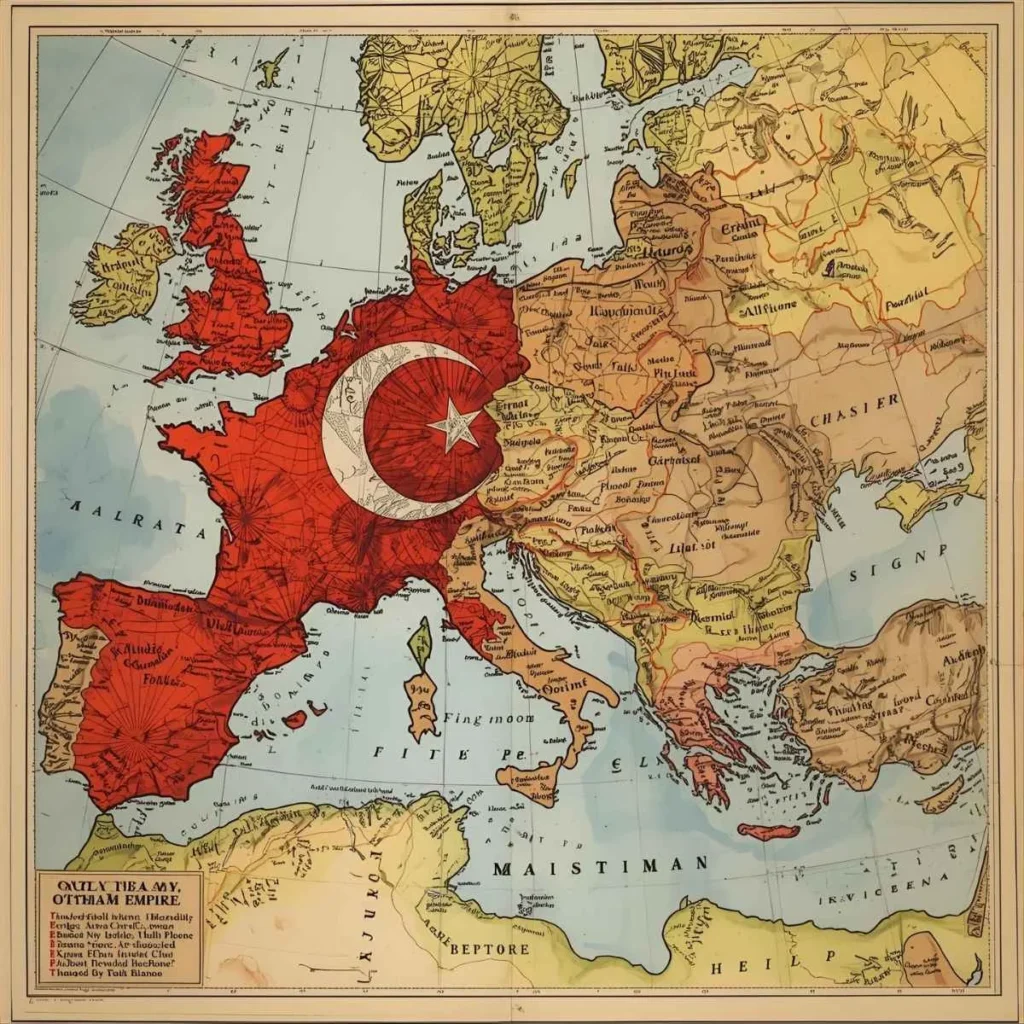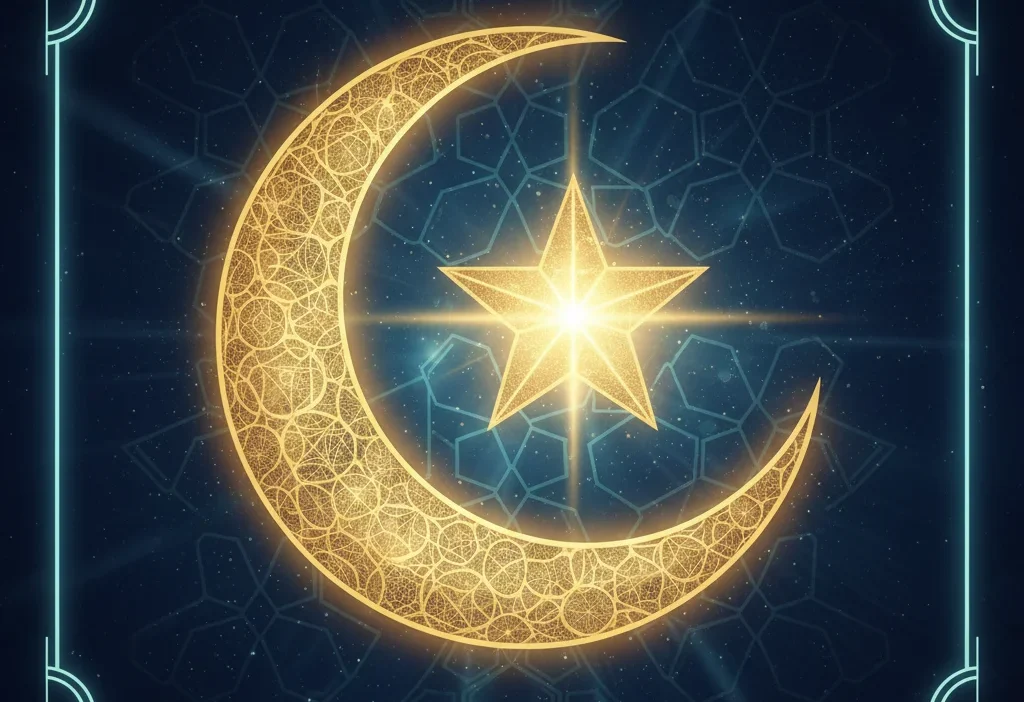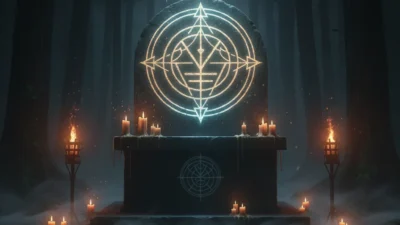🌙 The Universal Emblem of Faith
Across the globe, the crescent moon and star stand as one of the most recognized symbols of Islam. Seen on mosques, flags, and jewelry, this image instantly evokes thoughts of the Muslim world — but its story runs much deeper than decoration.
This iconic emblem carries layers of spiritual, cultural, and historical meaning. It represents not only divine guidance but also the rhythm of life, time, and renewal — all core themes in Islam.
Interestingly, the Prophet Muhammad (PBUH) and early Muslims did not use this symbol. Its association with Islam developed centuries later, shaped by history, culture, and faith traditions that merged under the banner of Islamic civilization.
The crescent and star became a visual language — simple yet profound — expressing identity, devotion, and the eternal light of faith guiding believers through life’s darkness.
🌟 Historical Origins of the Islamic Symbol
The origins of the crescent moon and star stretch back long before Islam. Ancient empires such as Byzantium, Persia, and even Mesopotamia used moon and star motifs to represent deities, time cycles, and cosmic order.

When the Ottoman Empire rose to power in the 14th century, it adopted the crescent and star as part of its flag. The image symbolized divine blessing, renewal, and the balance between heaven and earth.
As the Ottoman Empire expanded across Asia, Africa, and Europe, the crescent and star began to represent the unity of the Muslim world. It was proudly displayed on architecture, coins, and banners — becoming a global emblem of Islamic civilization.
Eventually, when modern Muslim nations gained independence, many — including Turkey, Pakistan, Tunisia, and Algeria — retained variations of the crescent and star on their national flags. Each design carried the same underlying message:
Faith, renewal, and divine guidance.
🕌 Spiritual and Cultural Meaning in Islam
In the spiritual context, the crescent and star have meanings that reflect the very heart of Islam’s teachings — humility before Allah, faith in His guidance, and the continuous cycle of renewal through prayer and reflection.
🌙 The Crescent: Faith, Renewal, and Time
The crescent moon is essential in Islam because the lunar calendar governs important religious observances. Ramadan, Eid al-Fitr, and Eid al-Adha all begin with the sighting of a new moon.
It represents rebirth, progress, and spiritual awakening — the promise that darkness will always give way to light.

In Sufism and Islamic mysticism, the crescent also symbolizes the soul’s journey toward enlightenment. Just as the moon reflects the sun’s light, believers reflect Allah’s wisdom and mercy through faith and good deeds.
⭐ The Star: Divine Light and Knowledge
The five-pointed star often accompanying the crescent symbolizes divine light. Many interpret it as representing the Five Pillars of Islam — faith, prayer, charity, fasting, and pilgrimage.
It is also seen as a guiding star, leading believers toward truth, righteousness, and peace — much like how stars guide travelers in the desert.
🕋 Together: Unity and Balance
When combined, the crescent and star become a symbol of balance and harmony — between body and spirit, day and night, life and afterlife.
The moon’s curve embraces the star, suggesting protection and divine care, reinforcing the message that faith shelters and guides humanity.
📜 Evolution of the Symbol Across the Muslim World
After the Ottoman era, the crescent and star gained popularity as a pan-Islamic identity symbol.

- In Turkey, it represents renewal after centuries of empire, now tied to both cultural pride and faith.
- In Pakistan, the crescent symbolizes progress and enlightenment, while the star reflects the light of knowledge and guidance.
- In Malaysia and Algeria, it conveys unity among diverse Muslim populations.
This widespread use turned the crescent and star into a universal Islamic symbol, recognized even among non-Muslims as representing the faith’s values — peace, balance, and trust in divine wisdom.
Despite regional differences, the essence remains the same:
The crescent and star remind Muslims to follow the light of Allah, no matter where they are in the world.
💫 The Symbol Beyond Religion: Cultural and Modern Relevance
In modern times, the crescent and star transcend religious meaning. They appear in art, fashion, architecture, and design — often as expressions of identity and unity.
Muslim artists reinterpret the symbol to celebrate heritage while reimagining it for today’s world. A minimalist crescent pendant, a glowing moon over a mosque, or even digital designs featuring stars — all reflect pride in spiritual and cultural roots.
This adaptation mirrors how Islam encourages balance between tradition and progress. Faith doesn’t stay static; it evolves with time, remaining meaningful and accessible to each new generation.
Online, the symbol has also become a digital emblem of solidarity, appearing in social media bios, artwork, and educational content — connecting Muslims worldwide through shared understanding.
It shows how visual symbols still have power to unite, inspire, and teach — especially when used authentically and respectfully.
🌍 The Crescent in the Islamic Calendar and Rituals
Islam’s calendar (the Hijri calendar) is purely lunar, unlike the solar-based Gregorian calendar. This makes the moon central to Muslim life.
Each month begins when the new crescent is sighted, and this determines the timing of major rituals.
- Ramadan: Starts with the first crescent moon, marking the beginning of fasting.
- Eid al-Fitr: Celebrated after the new moon, signaling the end of Ramadan.
- Hajj: The pilgrimage to Mecca, guided by lunar dates.
Thus, the crescent doesn’t only symbolize faith; it regulates the spiritual rhythm of Muslim life — connecting timekeeping, devotion, and community.
In essence, the moon reminds believers that every phase has meaning — whether it’s the quiet darkness of reflection or the full light of fulfillment.
✨ Misconceptions and Clarifications
Despite its popularity, it’s important to note that the crescent and star are not official religious symbols mandated by Islam.
The Quran and Hadith do not assign symbolic icons to faith. Islam traditionally discourages the worship or veneration of physical symbols to maintain focus on Tawheed — the oneness of God.
However, the crescent and star evolved as cultural emblems representing the Islamic world’s shared heritage, not as objects of worship.
This distinction reflects the balance between cultural expression and spiritual truth — Muslims may embrace the crescent as a sign of identity while keeping faith firmly centered on Allah alone.
🧭 Why the Crescent and Star Still Matter Today
In today’s diverse, globalized world, symbols act as bridges of understanding. The crescent and star help represent Islam’s values to people of all backgrounds.
It communicates peace, humility, and guidance — concepts deeply needed in modern life.
When used thoughtfully, it reminds Muslims and non-Muslims alike that Islam’s essence is light, balance, and compassion, not division or fear.
Educators, artists, and writers who explore such meanings authentically foster cultural literacy and appreciation — creating a more informed and empathetic digital environment.
🕊️ FAQs about the Islam Symbol
Q1: Is the crescent and star mentioned in the Quran?
No. The Quran does not mention any symbol for Islam. The crescent and star became associated with Islamic culture centuries after the religion began.
Q2: What does the crescent moon symbolize in Islam?
It represents renewal, progress, and the Islamic lunar calendar — which governs important religious observances.
Q3: What does the star represent in the Islamic symbol?
The star is often linked to divine light, knowledge, and guidance — sometimes interpreted as the Five Pillars of Islam.
Q4: Are all Muslim countries using the crescent and star?
Not all. Some nations use alternative Islamic imagery, but many — like Turkey, Pakistan, and Algeria — feature it prominently in their national symbols.
Q5: Is it wrong to use the crescent and star as jewelry or decoration?
No, as long as it’s used respectfully. Many Muslims wear it as a cultural or faith-based emblem rather than a religious requirement.
Q6: What’s the difference between cultural and religious use of the symbol?
Religious use refers to practices or rituals from scripture, while cultural use reflects heritage, identity, and unity within Muslim-majority societies.
🌙 Conclusion
The crescent and star stand as a timeless emblem of Islamic faith, culture, and unity. Though not born from scripture, they have come to represent the soul of a civilization — one that finds strength in balance, wisdom in light, and renewal in every new phase.
They remind Muslims of Allah’s guidance, the beauty of renewal, and the shared spiritual journey that connects believers across continents and centuries.
Ultimately, the symbol teaches a universal truth — that light always follows darkness, and faith, like the moon, is ever-renewing.

Oscar Wilde combined wit, beauty, and deep symbolism to reveal the spiritual contrasts of human life. His works often reflect the journey of the soul — from desire and art to truth and redemption. Wilde’s timeless reflections remind readers that beauty and wisdom are paths to understanding the divine within.



